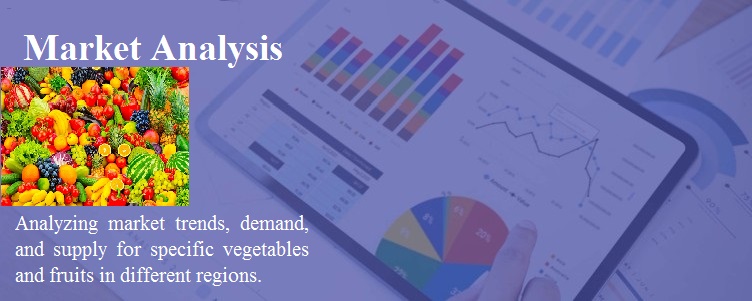Analyzing market trends, demand, and supply for specific vegetables and fruits in different regions.
Introduction
Analyzing market trends, demand, and supply for specific vegetables and fruits in different regions can provide valuable insights for businesses and individuals involved in the agriculture and food industry. Here are some steps you can take to conduct this analysis:

1. Identify the Specific Vegetables and Fruits
Start by selecting the specific vegetables and fruits you want to analyze. Consider factors such as their popularity, consumption patterns, and market value. This selection will form the basis for your in-depth analysis.
2. Gather Market Data
Collect relevant data about the vegetables and fruits you have chosen. This could include information on production volumes, imports/exports, prices, and consumption patterns. Utilize market reports, industry publications, government data, and trade associations as sources of information. Be thorough in your data collection process to ensure accuracy.
3. Analyze Demand
Examine the drivers of demand for the selected vegetables and fruits in different regions. Look for factors such as changing consumer preferences, population growth, dietary trends, and income levels. Consider analyzing historical data, consumer surveys, and market research reports to understand demand patterns and forecast future trends. This analysis will help you anticipate shifts in consumer behavior.
4. Assess Supply
Evaluate the supply side for the selected vegetables and fruits. Look at factors such as production volumes, acreage, yields, and availability of inputs such as land, labor, and technology. Consider analyzing historical data, agricultural reports, and industry studies to assess supply capacity and potential. Understanding supply dynamics is crucial for gauging market stability.
5. Study Market Trends
Identify market trends related to the selected vegetables and fruits. Look for factors such as emerging food trends, new product developments, regulatory changes, and technological advancements. Analyze market reports, industry news, and trade publications to stay updated on current and upcoming trends. Staying ahead of the curve is essential in a dynamic market.
6. Regional Analysis
Analyze how demand, supply, and market trends vary across different regions. Consider factors such as climate, geography, cultural preferences, and economic conditions. Assess regional differences to identify potential opportunities or challenges in specific markets. Tailoring your strategies to regional nuances can be highly effective.
7. Competitive Analysis
Study the competition within the specific vegetable and fruit market. Identify key players, their market share, pricing strategies, distribution channels, and product differentiation. Analyze industry reports, company financials, and news articles to gain insights into competitor dynamics. Knowing your competition is essential for crafting a successful market strategy.
8. Generate Insights and Recommendations
Analyze the collected data and draw conclusions based on your findings. Identify opportunities for growth, potential market gaps, and areas for improvement. Generate actionable recommendations to capitalize on market trends and meet the demand for specific vegetables and fruits in different regions. Your recommendations should be informed by a comprehensive understanding of the market landscape.
Conclusion
In conclusion, conducting a thorough analysis of market trends, demand, and supply for specific vegetables and fruits in different regions is a multifaceted process that requires attention to detail and a holistic view of the industry. Regularly updating your analysis is crucial to adapt to the ever-changing market dynamics and maintain a competitive edge. Staying informed about new developments and continuously monitoring the market will enable you to make informed decisions and adapt to evolving conditions effectively.
Rad Golden Leaf General Trading LLC is a reputable company specializing in the export of fruits and vegetables, adhering to international trade principles. Additionally, the company is involved in the import of raw tobacco materials. Their strong commitment to quality and compliance with industry standards has established them as a trusted player in the global agricultural and tobacco supply chain. Their dedication to excellence ensures that customers receive top-notch products and services in both the export and import sectors.
